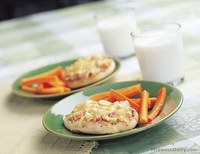Prairie Fare: Are You a Sun Seeker After a Long Winter?
(Click an image below to view a high-resolution image that can be downloaded)
By Julie Garden-Robinson, Food and Nutrition Specialist
NDSU Extension Service
I noticed the houseplants on the window sills of our home were leaning toward the sun. In fact, some of my plants on tables appeared as though they might topple onto the floor as they stretched their green “necks” toward the light.
My overwintered blooming red geraniums had their “faces” pressed up against the window panes. My geraniums want to go outside. So do I.
Scientists have a name for this tendency to follow the sun. “Heliotropism” is the name of plants’ movement toward the sun. If you ever have driven by a beautiful field of blooming sunflowers with their faces pointing toward the sun, you know what I’m talking about.
I think many of us may be feeling a little “heliotropic” these days. I could use some sunlight after a long winter when I arrive at work in the dark and return home in the dark.
We know that we need to protect our skin from too much sun exposure, which could increase our risk for skin cancer. Health experts recommend minimizing our sun exposure, especially between 10 a.m. and 4 p.m., using ample SPF (sun protection factor) 30 or higher sunscreen, and wearing wide-brimmed hats, ultraviolet-protective sunglasses and long-sleeved clothing.
Despite the risks, did you know that a little sunlight has beneficial effects on nutritional status? Our skin can form vitamin D from sun exposure. According to vitamin D researchers, five to 30 minutes of sun exposure twice a week can help our skin form vitamin D.
Vitamin D is best known for its role in building and maintaining bones because it helps our body absorb calcium. Children and adults need vitamin D, calcium and a wide variety of nutrients to keep bones strong throughout their lifetime.
Our bones are not static; they constantly are being remodeled. Nourishing and exercising our bones may help protect us from osteoporosis.
Besides bone health, adequate vitamin D may help prevent colon cancer and potentially some other cancers, at least according to some research. More research is under way.
Other researchers are examining the role that vitamin D may play in reducing the risk for type 1 diabetes, multiple sclerosis, heart disease, depression and other diseases.
Some people are more likely to be deficient in vitamin D. Those of us with limited sun exposure are at risk for vitamin D deficiency. Other at-risk groups include infants who are breastfed exclusively, older adults, those with dark skin, and those who are obese or who have undergone gastric bypass surgery.
Those of us who are inside buildings the better part of six months out of the year need to rely on food and supplements. We have a few foods available that are good sources of vitamin D, but we need to think about our food choices to meet our needs.
You may have heard your parents or grandparents mention having spoons of cod liver oil as children. Cod liver oil is an excellent, although not the tastiest, source of vitamin D.
Other fish such as salmon, tuna and sardines also are good natural sources of vitamin D. Fortified orange juice and milk provide vitamin D. Liver, eggs and fortified cereals also provide vitamin D.
The recommended dietary allowance for vitamin D varies with age. For example, infants to age 1 need 400 international units (IU) per day. From age 1 to 70, the recommendation is 600 IU per day and at 70 years, the recommendation is 800 IU.
Be aware that some people need far more than the current recommendation. Your medical provider may run lab tests to determine your vitamin D status. Your provider may prescribe therapeutic doses of vitamin D supplements to increase the vitamin D levels in your blood, so be sure to follow that advice.
When you find yourself peering out your window at the sun on cold, gray days, like a plant in pursuit of sunlight, remember that a little sunlight is OK. When warm, sunny days arrive, take the precautions against getting too much sun. Be sure to think about your food selections and, potentially, supplements to be sure you are taking in enough vitamin D all year long.
This recipe features vitamin D-rich tuna and is courtesy of the Midwest Dairy Association. Enjoy this sandwich with a glass of vitamin D-fortified milk. Visit https://www.ag.ndsu.edu/boomers/bones-joints to learn more about nourishing your bones throughout life.
Heartfelt Tuna Melt
6 ounces solid white tuna packed in water, drained
1/3 c. chopped celery
1/4 c. chopped onion
1/4 c. low-fat Thousand Island dressing
2 whole-wheat English muffins, split
3 ounces reduced-fat cheddar cheese, grated
Salt and black pepper to taste
Preheat broiler. Combine tuna, celery, onion and salad dressing. Season with salt and pepper. Toast the English muffin halves. Place split side up on baking sheet and top each with one-fourth of the tuna mixture. Broil two to three minutes or until heated through. Top with cheese and return to broiler until cheese is melted, about one minute longer.
Makes four servings. Each serving has 140 calories, 7 grams (g) fat, 7 g protein, 13 g carbohydrate, 2 g fiber and 330 milligrams sodium.
(Julie Garden-Robinson, Ph.D., R.D., L.R.D., is a North Dakota State University Extension Service food and nutrition specialist and professor in the Department of Health, Nutrition and Exercise Sciences.)
NDSU Agriculture Communication - March 9, 2017
| Source: | Julie Garden-Robinson, 701-231-7187, julie.garden-robinson@ndsu.edu |
|---|---|
| Editor: | Ellen Crawford, 701-231-5391, ellen.crawford@ndsu.edu |



